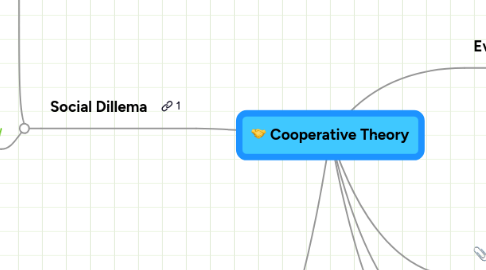
1. Social Dillema
1.1. Concept
1.1.1. situation in which individual rationality leads to collective irrationality!
1.1.2. "These are not a problem that education solves!" Peter Kollock
1.1.3. study of
1.1.3.1. the tensions between
1.1.3.1.1. individual rationality
1.1.3.1.2. collective rationality
1.1.3.2. categorization
1.1.3.3. possible solutions
1.1.4. market by
1.1.4.1. deficient equilibrium
1.1.4.1.1. there is at least one other outcome in which everyone is better off.
1.1.4.1.2. no one has an incentive to change their behavior.
1.1.4.2. dominating strategy
1.1.4.2.1. best outcome for an individual regardless of what anyone else does.
1.1.5. 3 conditions
1.1.5.1. Meeting in the Future
1.1.5.2. Identify each Other
1.1.5.3. Record of past Behavior
1.2. Metaphors
1.2.1. Prisoner's Dilemma
1.2.1.1. Assurance Game
1.2.1.2. Chicken Game
1.2.1.3. PD Strategies:
1.2.1.3.1. Tit for Tat
1.2.1.3.2. Don't be envious
1.2.1.3.3. Encorage Frequent and Durable Interations
1.2.1.3.4. Improve recognition and recall
1.2.1.3.5. Be Generous
1.2.2. Resources Environments
1.2.2.1. The Commons
1.2.2.1.1. Common Pool Resources (CPR)
1.2.3. Tragedy of Commons
1.2.3.1. The concern!
1.2.3.1.1. a class of human problems
1.2.3.1.2. which are "no technical solution problems"
1.2.3.1.3. Tragedy?
1.2.3.2. Examples
1.2.3.2.1. Population Problem
1.2.3.2.2. herdsman seeking to maximize his gain!
1.2.3.2.3. freedom of the seas
1.2.3.2.4. pollution
1.2.3.2.5. Cold war!
1.2.3.3. What shall we do?
1.2.3.3.1. Private Property
1.2.3.3.2. Allocate the right to enter
1.2.3.3.3. Morality!
1.2.3.3.4. Prohibition
1.2.3.3.5. Social Arrangements
2. GameTheory
3. Evolution
3.1. Stages
3.1.1. Biology
3.1.2. Culture
3.1.3. Institution
3.2. Mechanisms
3.2.1. Direct reciprocity
3.2.1.1. "You help me, and I help you."
3.2.1.2. game is played several times
3.2.2. Indirect reciprocity
3.2.2.1. "I help you, somebody helps me."
3.2.2.2. New node reputation (and gossip)
3.2.3. Spatial selection
3.2.3.1. Neighbors help each other.
3.2.4. Group selection
3.2.4.1. Tribes and common goods.
3.2.5. Kin selection
3.2.5.1. Interaction occurs between genetic relatives
3.3. Relation
3.3.1. Donor
3.3.1.1. pays a cost
3.3.2. Recipient
3.3.2.1. gets a benefit
3.3.3. Measured in fitness
3.3.3.1. fitness is rate of reproduction
3.3.3.1.1. reproduction can be
3.3.4. Winning strategy
3.3.4.1. Generous
3.3.4.2. Hopeful
3.3.4.3. Forgiving
4. Related Idea
4.1. Wisdom of Crowds
4.1.1. Concept:
4.1.1.1. Crowd can be more then its members!
4.1.1.2. Act collectively to...
4.1.1.2.1. make decisions
4.1.1.2.2. solve problems
4.1.2. Types of Problems:
4.1.2.1. 1-cognition
4.1.2.2. 2-coordination
4.1.2.3. 3-cooperation
4.1.3. Conditions:
4.1.3.1. 1-Diversity
4.1.3.2. 2-Independency
4.1.3.3. 3-Decentralization
4.1.3.4. 4-Agregation
5. Usage
6. Motivation
6.1. SDT
6.1.1. the social context can either support or thwart the natural tendencies toward active engagement and psychological growth
6.1.2. About
6.1.2.1. The interplay between
6.1.2.2. extrinsic forces acting on persons
6.1.2.3. intrinsic motives inherent in human nature
6.1.3. Framework
6.1.3.1. Watchs
6.1.3.1.1. Social and Cultural factors
6.1.3.1.2. sense of volition and initiative
6.1.3.1.3. well-being and performance quality
6.1.3.2. Variables
6.1.3.2.1. autonomy
6.1.3.2.2. competence
6.1.3.2.3. relatedness
6.1.4. THE Theory
6.1.4.1. Cognitive Evaluation Theory (CET)
6.1.4.1.1. Intrinsic motivation
6.1.4.1.2. studies influences of:
6.1.4.2. Organismic Integration Theory (OIT)
6.1.4.2.1. extrinsic motivation
6.1.4.3. Causality Orientations Theory (COT)
6.1.4.3.1. Autonomy orientacion
6.1.4.3.2. Control orientation
6.1.4.3.3. Impersonal or amotivated orientation
6.1.4.4. Basic Psychological Needs Theory (BSNT)
6.1.4.4.1. Studies influence of psychological well-being and optimal functioning on autonomy, competence, and relatedness
6.1.4.5. Goal Contents Theory
6.1.4.5.1. Studies the intrinsic and extrinsic goals and their impact on motivation and wellness
